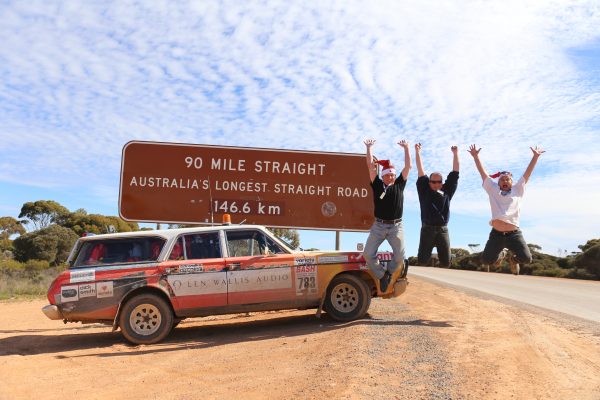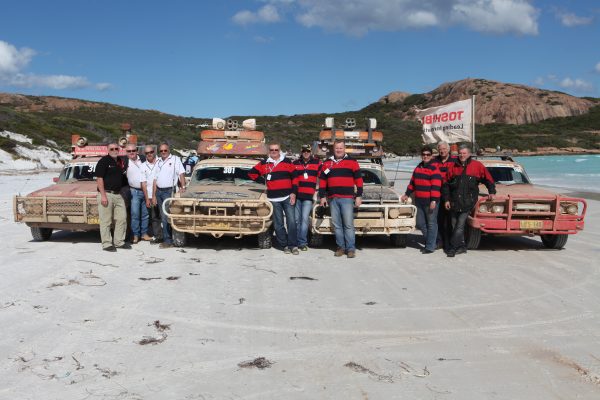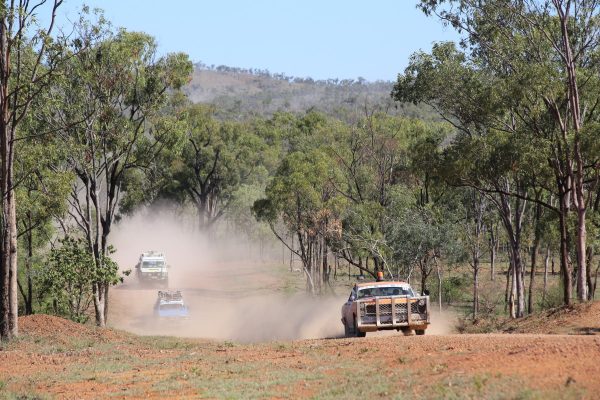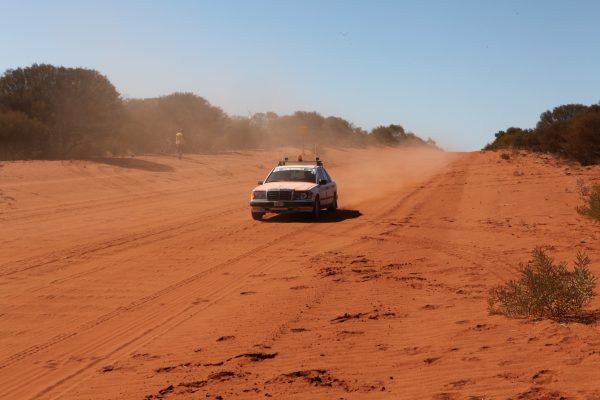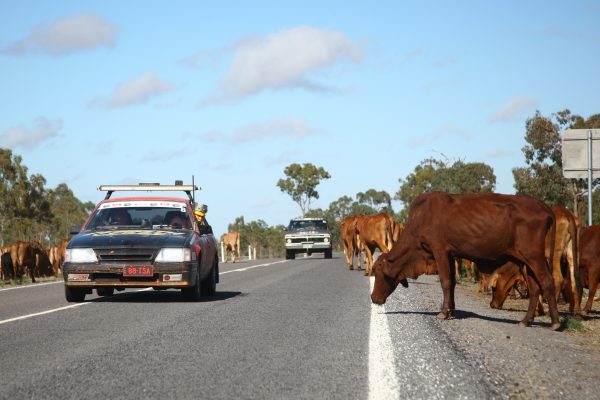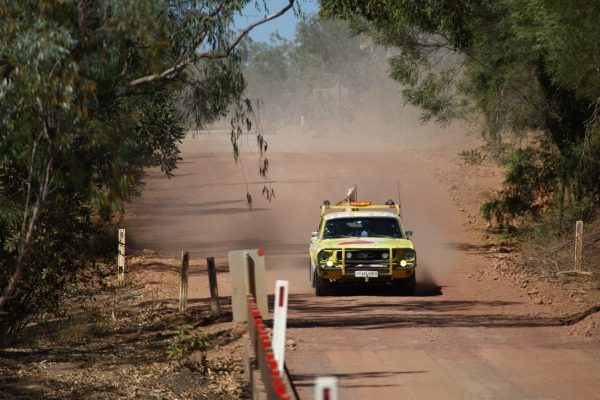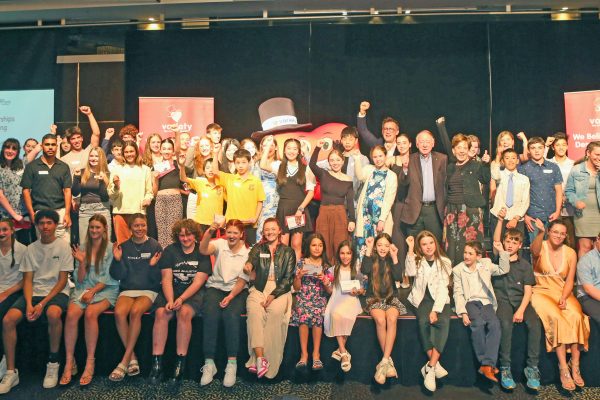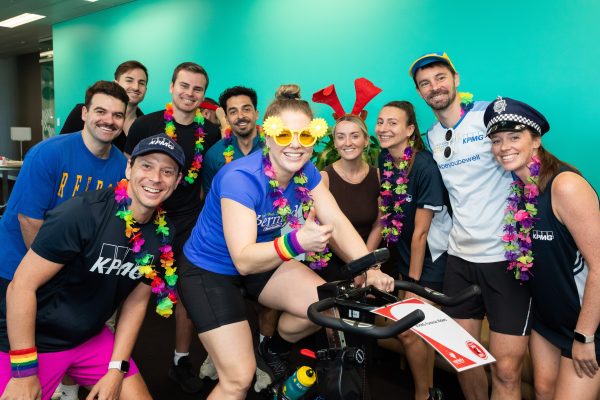The Variety Brydens Lawyers Bungarribee to Bakers Creek B to B Bash
In 1985, businessman and philanthropist Dick Smith got a bunch of his mates to drive their old cars through the outback from Bourke in Far West New South Wales to Burketown in Far North Queensland. He charged people to enter to fundraise for charity and managed to raise $250,000. It became known as the Variety Bourke to Burketown Bash and became an annual tradition with each trip beginning and ending in a town beginning with “B.” The B to B Bash is Australia’s most successful charity motoring event.
Want to know where we’re headed on this year’s Variety Bryden’s Lawyers Bungarribee to Bakers Creek B to B Bash? Or maybe you’re a little curious on what to expect from the day-to-day of a Variety motoring event? Read on to get the lowdown on this extraordinary adventure kicking off on Sunday 7th August. Don’t miss out – register now!
Day 1:
This year, our start line is at Sydney Zoo in Bungarribee, Western Sydney. In 1882, Bungarribee was established for the purpose of breeding horses for the East India Company. Many of Australia’s most prominent racehorses trace their bloodlines to Bungarribee. You’ll see local streets are named after their horses, like Steeltrap Drive named after one of the most successful horses of the 1820s and 30s. Sydney Zoo occupies a 16.5-hectare (41-acre) site in Bungarribee and aims to create amazing experiences for the community by introducing them to a range of animal species from all over the world, while also educating on animal welfare and conservation. The zoo was opened in December of 2019 and we at Variety are delighted to say we have been their Charity Partner from that time.
We then set off for Crookwell, a picturesque town which is also one of the state’s major producers of seed potatoes, wool, lamb, beef cattle, oats, hay, dairy producer and cold-climate fruits – a good place to stop for lunch! Dame Mary Gilmore was also born in the area in 1865. Next, we’ll be heading for Cowra, known for its vineyards and furniture making on the Lachlan River.
Day 2:
Our first breakfast on this year’s B to B Bash will be at Mulyan Public School. The school is an active participant in the social fabric of Cowra with their students being a part of many local activities that extend beyond the school. After brekky, we hit the road for Jugiong, a town of 200 with an interesting history. In 1864, as gold was discovered in the area, Johnny Gilbert, Ben Hall and John Dunn held up a mail coach between Gundagai and Jugiong. Hall and his gang ended up killing 32 year-old Edmund Parry, a Sergeant of the N.S.W. Police. By the time the mail coach had arrived they had held up nearly 60 people in a single day. After our lunch with Jugiong Public School, we head West to Griffith.
Griffith, thought by early white settlers to be barren and uninhabitable, is now the richest tract of agricultural country in Australia. Thanks to Samuel McCaughey’s success of developing a local irrigation system in 1906 which transformed the area into a fertile agricultural oasis. After World War I, many Italian migrants, attracted by the similarity of the landscape to their home country, moved to the area. They brought with them their traditions of viticulture and market gardening to the immense benefit of the district. They capitalised on, and greatly enhanced, a winemaking industry which began in 1913 when J.J. McWilliam planted 40,000 grape cuttings on his block at Hanwood. He built the Hanwood Barrel Winery in 1917 to process his grapes. Today the surrounding wineries produce 80 per cent of NSW’s and 20 per cent of Australia’s wine grapes.
Day 3:
We’ll be having breakfast at the Kalinda School which caters to students aged four to 20 who have an intellectual or physical disability. They focus on the unique needs of each of their 30 students, expressed through individual education plans containing carefully selected and clearly defined educational priorities. We will then travel about 250km to Ivanhoe, a quiet, unassuming town characterised by a particularly wide main street. Ivanhoe is a railhead and service centre for the surrounding pastoral industry and a stopover for those travelling on the Cobb Highway. This will be our lunch stopover, too, at the Ivanhoe Central School, which first opened in 1889.
Next, we will hit the road for The Silver City, the Oasis of the West, the Capital of the Outback: Broken Hill. An isolated mining town by the South Australian border, the town is surrounded by semi-desert. The town was founded in 1883 by a boundary rider called Charles Rasp, who discovered what he thought was tin but turned out to be silver. The Broken Hill Proprietary Company (BHP) was founded in 1885. As the mineral resources in the Broken Hill area dwindled, tourism has become increasingly important to the city’s economy. The town is known as a centre for artists, and several galleries line the streets. Sheep farming is now one of the principal industries in the area and there are more sheep than people — almost two million Merino sheep!
Day 4:
After stopping at Morgan Street Public School for breakfast, we’ll head for Tilpa, known for its fishing and iconic outback pub. Tilpa is a rewarding stopover on the scenic Darling River Run. This peaceful and historic town on the western banks of the Darling River was once a busy port for the bustling paddle-steamer river trade. Established in 1894 to service the river boat trade, the Tilpa Hotel is one of the last remaining bush pubs in Australia. Built of corrugated iron and timber, it’s the place for a chat with the friendly locals while you tuck into a classic counter meal. It’s also been the landing spot for many of our Bash lunches over the years and our lunch stop-over will be catered for by the Tilpa Community Committee in the community hall across the street from the pub.
Driving north-east, Bourke will be our next stop. Located where the Kidman Way meets the Darling River, Bourke is a town firmly etched in Australian folklore and is the ideal access point for The Darling River Run. Bourke provides a true Outback experience to all who visit this iconic Bash favourite town, from where Dick Smith officially started the first B to B Bash 37 years ago. In the second half of the 1800s, the Port of Bourke was the focus of the world’s wool industry with up to 80 riverboats servicing the region and at one time it was one of the largest in the world. Today, while wool is still produced here, cotton has taken over as the major industry. Bourke also boasts a thriving horticultural industry, which produces an abundance of grapes, citrus, plums, apricots and melon as well as a variety of vegetable crops. Alternative native crops such as peanuts, jojoba and the unique Napunya honey are also produced in the area.
Day 5:
Bourke Public School will be hosting us for breakfast before we cross the border into Queensland and head for Hungerford – an appropriate name for our lunch stop! Named after politician Thomas Hungerford, the town and surrounding area has a population of just 23 people. Writer and bush poet Henry Lawson wrote of Hungerford “the town is right on the Queensland border, and an interprovincial rabbit-proof fence – with rabbits on both sides of it – runs across the main street…Hungerford consists of two houses and a humpy in New South Wales, and five houses in Queensland. Characteristically enough, both the pubs are in Queensland.”
Next, we’ll travel north-east to Cunnamulla on the Warrego River. The township of Cunnamulla was created by Cobb & Co. who, on the 3rd September 1879, drove the first coach through from Bourke. Cunnamulla was one of many settlements which grew in South-West Queensland as a result of the activities of Cobb & Co., but it is the only one to have survived. In the 1880s farmers moved into the area and found the open plains to be perfect for sheep grazing. Today over two million sheep graze in the region’s pastures.
Day 6:
Breakfast will be provided by the Cunnamulla State School, which was founded in 1877 and was Cunnamulla’s first school. The school draws its enrolments from both the town of Cunnamulla and a few rural residences and has approximately 145 students, which fluctuates throughout the year. Students will often move to a different area to be with family members for some months and then return. As a result, students often have quite large gaps in their attendance and need to cope with constant changes in the education environment.
We’ll then hit the road to Quilpie, the centre for a number of tiny settlements which exist in the far western Outback regions of Queensland. Quilpie’s major claim to fame is the altar in St Finbarr’s, the Roman Catholic Church. In keeping with the mining background of the area the altar has been made from opal rocks which historically the area is known for. There are also some excellent fishing holes in and around Quilpie, Golden Perch (aka yellowbelly) and freshwater crayfish (yabbies) are the most common catches. Quilpie State College will be hosting us for lunch on this day.
Driving east, we will head for Charleville, a town with its history firmly rooted in Australia’s infant aviation industry. On November 2nd 1922 the first regular Qantas service took off from Charleville with a 400-pound payload and 160 letters, bound for Cloncurry. Today these links with transportation are still important. The town is home to both the southern Queensland base of the Royal Flying Doctor Service and the School of Distance Education. Charleville also has a wildlife sanctuary, including a bilby reserve and an observatory, the Cosmos Centre.
Day 7:
After breakfast at Charleville State School, we’ll be driving southeast to Bollon, a town of around 220 people on the banks of Wallam Creek. River red gums along the creek are home to a large colony of koalas. The town is also known to have emus strolling the streets. For lunch, we will be hosted by the Bollon State School P&C at the Bollon Showground. Bollon is a small, two-teacher school providing education to the 10 children of Bollon and the surrounding area. They are very proud of being able to provide a high-quality education to their students. Bollon State School is focused on delivering a quality education for all and is supported with dedicated teacher-aides and visiting specialists.
After lunch we will travel on to Roma, a town at the heart of a rich sheep and cattle grazing area which boasts the largest store cattle market in Australia. In 1846, Sir Thomas Mitchell, the New South Wales Surveyor – General, passed through the area looking for a route from Sydney to the north coast of the continent. On 7th May 1846, Mitchell reached Mount Abundance (so named because he was impressed by the richness of the region). The town was gazetted in 1862 and was named Roma after Lady Roma Bowen, the wife of the Queensland Governor of the time. It was the first town gazetted in the new colony of Queensland. In Roma, you can look forward to a large number of gracious old houses, the unusual tower of the School of Arts Hotel (built in 1918), and our dinner at the Roma Gun Club where we will be shooting at clay pigeons just like we did back in 2012 when we were last here! In keeping with the theme, this is also our ‘gun-slinger’ night!
Day 8:
Our breakfast in Roma will be a little bit different to our normal gathering locations – it’s in the backyard of Roma locals, Robert and Edith Burton, at “Up the Creek Garage and Museum.” Their families have been in the Roma region for five generations now and after visiting numerous small museums during their travels to America, New Zealand and around Australia, they felt overwhelmingly inspired and so, “Up the Creek Garage” was born in May 2017. Proudly, all of the cars and other relics in this museum are family owned. Not only are there cars but Tex and Jack, their ‘pet’ Longhorn Texas cows are on show too! You can get up close-and-personal with them or try your hand at Horseshoe Throwing or the Cornhole Challenge! A Bash Breakfast with a difference.
Travelling north, we head for Cracow, a gold mining town in the Banana Shire area. The town was named by pastoralist John Ross, in 1851, after the Polish city of Kraków, which had recently been the centre for a fight for Polish national independence. The local hotel, where lunch will be served, is one of the only remaining retail business, as it attracts a lot of tourists due to its unusual array of strange artefacts adorning the ceilings and walls. The 2019 horror-comedy film Two Heads Creek was filmed on location in Cracow.
As we drive further north, we head for the unofficial capital of Central Queensland, Rockhampton. The city’s early wealth was built on the gold which was discovered in the hinterland. The first wave of miners in the 1860s did not have a major impact on the development of the city. It was the later discoveries, particularly at Mount Morgan which created the wealth out of which the city’s stately buildings were constructed. Today Rockhampton proudly declares itself the ‘Beef Cattle Capital of Australia,’ with life size statues of bulls in the median strip at both the northern and southern ends of town. Rockhampton is also home to novelist Ernestine Hill (1900-1972) who wrote My Love Must Wait, a popular account of the life of Matthew Flinders, and Rod Laver, the man reputed to be the greatest tennis player ever.
Day 9:
Hall State School will host us for breakfast. Established in 1900, the school boasts a gifted education ‘Honours Program,’ a special education program and is renowned for its environmental programs. The school has won many awards including ‘Reef Guardian’, ‘Green and Healthy’ and recycling awards. They have a strong instrumental music program with a number of bands and orchestras, five choirs and three speech choirs which regularly win prizes in Eisteddfods.
Then, we will drive further north up the coast to St Lawrence, one of the oldest towns on the coast of Queensland. The St Lawrence Wetlands contains freshwater fish habitats and abundant bird life and there are great fishing and crabbing spots close by and we’ll have. lunch at St Lawrence State School.
After lunch, we travel on to the tropical city of Mackay. Its wide streets are characterised by beautifully kept median strips with ‘Royal’ palm trees and flowering tropical plants. In 1865, John Spiller planted the first sugar crop in the area and the first sugar was exported in 1867. It was around this time that South Sea Island labourers were brought to the area as slave labour to work on the sugar plantations. At the time, the tropics were not considered a suitable work environment for white people and South Sea Islanders continued to work on the plantations until 1906. In 1939 an artificial deep-water harbour was built with the largest sugar terminal in the Southern Hemisphere jutting out to load ships with the hinterland’s produce. It has been estimated that the area around Mackay produces over 25 per cent of all Australia’s sugar.
Day 10:
Hosted for breakfast by Dundula State School, Baker’s Creek is known as an excellent fishing spot but is also home to some crocs so anglers are advised to be on the lookout!
For dinner, we will head back to Mackay for a final night of fun and to celebrate 10 days of seeing our beautiful country and remembering what it’s really all about – doing it for the kids. We will be hosted by the Mackay Entertainment and Convention Centre and dance the night away to Jade Holland and her band!
For more info on the Variety Brydens Lawyers Bungarribee to Bakers Creek B to B Bash, click here.
If you have any questions, please do not hesitate to get in touch!

